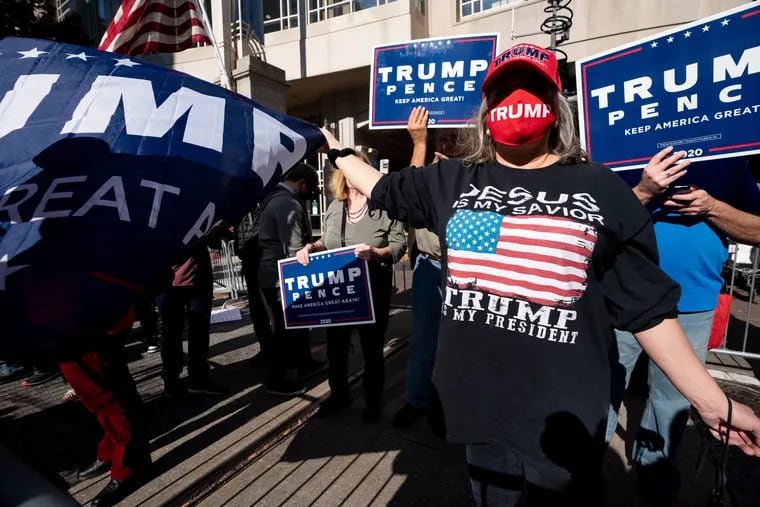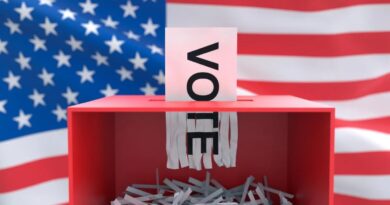Don’t believe Trump’s lies about the 2020 vote count being rigged in Philly. I know it wasn’t, because I was there.

Americans are once again being subjected to a torrent of lies about our elections. These fabrications are more than just the desperate excuses of a potential loser and his enablers. Much like they were four years ago, they are a danger to the public servants and volunteers who help make our democracy function.
In 2020, election workers across the country faced open intimidation as ballots were being tallied.
In Michigan, angry protesters tried to barge into Detroit’s TCF Center chanting, “Stop the count.” In Arizona, armed men joined demonstrators outside a counting center in Phoenix. Here in Philadelphia, two Virginia men with assault rifles were arrested near the Pennsylvania Convention Center, apparently convinced the election was being stolen there in real time.
I can assure you that it wasn’t, because I was there.
Voting concerns
A week before the election — and several months before I became a journalist and joined the Opinion desk at The Inquirer — I was one of the dozens of temporary workers and city employees at the Convention Center who received training in counting votes and was sworn into public service by City Commissioner Lisa Deeley. All of us there had signed up for the unprecedented task of counting what were expected to be hundreds of thousands of mail-in ballots.
In 2019, the state passed a bipartisan election law that removed the requirement that Pennsylvania voters needed a valid excuse to vote by mail. By 2020, the pandemic gave millions of voters plenty of reasons to not go to the polls, and what had traditionally been a small number of absentee ballots increased more than ninefold.
Nowhere was the task of counting these votes more difficult than in Philadelphia.
In rural counties, voters were much more likely to vote in person. Additionally, those counties have fewer votes to count overall, and fewer precincts to match them to. Out of the 2.6 million mail ballots in Pennsylvania that year, 365,000 were cast in Philadelphia.
Without adequate financial support from either the city or the state, city commissioners were forced to rely on support from a nonprofit to administer the elections. This generated conspiracy theories, but without that private support — which allowed not only paying vote counters but also helped purchase machines to sort, open, and count ballots — the count may have dragged on for weeks, increasing uncertainty.
When Election Day arrived, there was a sense of foreboding. As results trickled in, it became clear that Pennsylvania was likely to serve as the tipping point state. The news stations and the Associated Press were waiting on our vote count to make their calls. Shortly after the polls closed, law enforcement brought the last batches of mail ballots from the city’s drop-off stations, which closed at 8 p.m. After that, no more new ballots arrived.
It was time to get counting.
For those of us at the Convention Center, each batch of votes tallied represented progress in our mission, our way of ensuring that our friends, families, and neighbors had their voices heard. For Donald Trump and his army of delusional sycophants, they were evidence of a conspiracy to steal the election.
As was to be expected in an overwhelmingly Democratic city, every batch of votes went largely for Joe Biden, shaving down Trump’s Election Day margin with every release. Mail ballots were even more heavily in favor of the Democrats. Political scientists had predicted this so-called blue shift in advance of the election, but for Trump’s more fanatical supporters, this was just more evidence that the result was baked in.
I wish those who question the results could have seen us working inside the Convention Center. Counters were meticulous in following the law, erring on the side of strict interpretation. I personally reviewed thousands of ballots and was forced to remove hundreds for minor and inconsequential errors like a missing date or an absent secrecy envelope.
Older voters, who were the most likely to vote by mail, were also the most likely to have their votes disqualified.
Philadelphia was also the only county in the state to perform poll book reconciliation. That means going through mailed ballots to ensure no one who voted by mail also tried to vote in person. There are already multiple safeguards in place to protect against this happening, but given the stakes, the Board of Elections opted for caution. In 2020, with voters voting by mail en masse for the first time, there were roughly three dozen examples. In elections since, there have been none.
As the numbers got worse for the Trump campaign, some supporters became more desperate, and serious threats began.
Under pressure
I’ve known Seth Bluestein, then a chief deputy city commissioner, for more than 20 years, since our first day as freshmen at Central High School. He is a Republican, an Eagle Scout, and has spent his entire career in public service.
He has audited the city’s elections extensively and demonstrated that fraud is uncommon, and in the rare instances in which it does occur, offenders face consequences. Former U.S. Rep. Ozzie Meyers and notorious landlord Philip C. Pulley were both convicted in recent years on charges that originated with a referral sent by Bluestein.
None of that prevented Trump supporters from lobbing death threats and antisemitic invective at Bluestein and his family, simply for doing his job. His children, already missing their father because of his hectic postelection schedule, were forced to live under the watchful gaze of a Philadelphia police protection detail.
Bluestein was not the only election official to come under threat that year. Secretary of the Commonwealth Al Schmidt, who was a city commissioner during the vote count, was singled out by name on Trump’s Twitter account after defending the integrity of Philadelphia’s elections.
Schmidt, with whom I worked during the vote count, was indispensable four years ago, providing a professional, trustworthy, and knowledgeable voice of authority for millions of Americans who watched the news conferences he held during the count. Besides being the public face of the city’s counting efforts, Schmidt worked privately to assuage concerns about the validity of the vote.
On one occasion, then-U.S. Sen. Pat Toomey called Schmidt while he was on the Convention Center floor. While I was not privy to the conversation, I am personally convinced that Schmidt’s steadfast depiction of election reality played a role in Toomey’s decision to vote to convict Trump after his second impeachment.
Yet, no matter what Bluestein or Schmidt or anyone said, it was difficult to push back against the tide of lies coming from Trump. Two Virginia men believed those lies, grabbed their guns, and came to Philadelphia. Their arrest outside the Convention Center was a “mass shooting that was narrowly averted,” according to District Attorney Larry Krasner.
When the news spread on the Convention Center floor that we had all become targets, those of us who were hard at work counting ballots were alarmed, but unfazed. We kept our heads down, followed the law, and helped compile the tally that eventually determined who would step into the Oval Office two months later.
Whatever happens next week — with Trump steadfast in his lies and Republican state lawmakers obstructing measures that would help speed up the count — election workers will likely need that kind of quiet resolve yet again.
Daniel Pearson is an editorial writer at The Inquirer.


